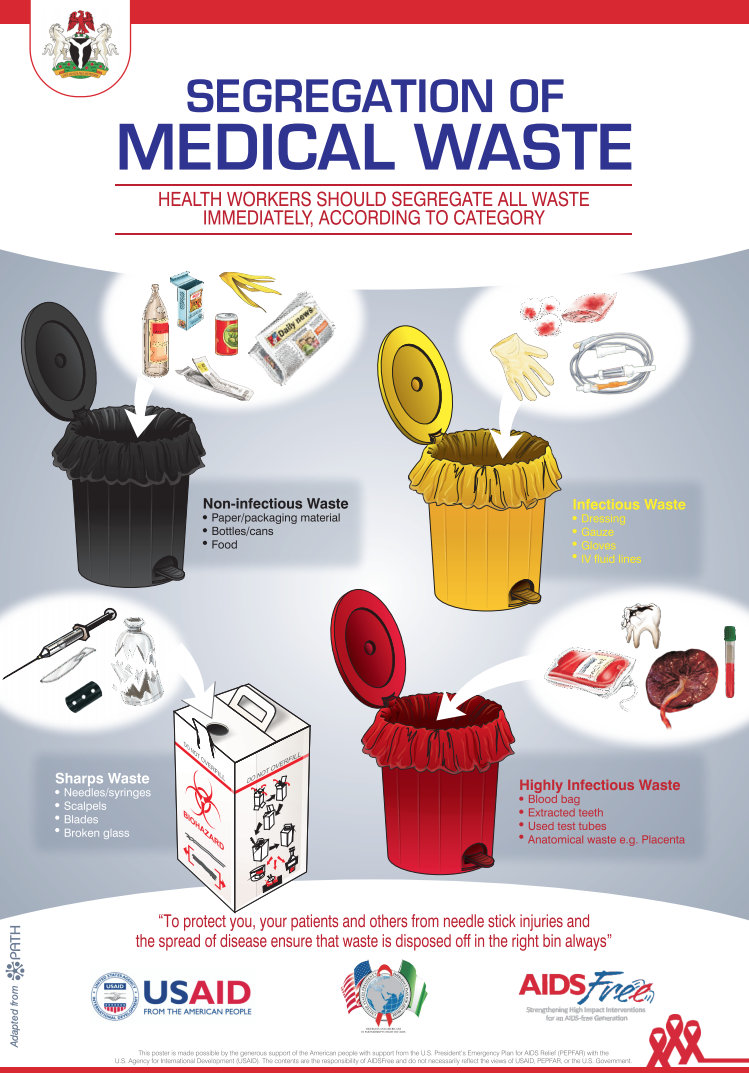Sustainable Solutions for Medical Garbage Disposal
The correct management and disposal of clinical waste is vital in maintaining a lasting and safe medical care system. This intro will certainly explore numerous lasting solutions for clinical waste disposal, consisting of waste segregation and sorting, on-site waste treatment systems, reusing and reuse programs, waste-to-energy conversion technologies, as well as collaboration and education campaigns.
Waste Partition and Arranging
The process of waste partition and sorting is important in making sure appropriate management and disposal of clinical waste. Medical waste is categorized right into various categories based upon its potential danger to human health and wellness and the environment. Proper partition and sorting of waste aid to lessen the risk of contamination and make sure that each kind of waste is handled and thrown away suitably.
The first action in waste partition and sorting is to determine and divide various sorts of medical waste at the factor of generation. This entails recognizing the various groups of waste, such as infectious waste, sharps waste, pharmaceutical waste, and chemical waste. medical waste disposal service. Each category requires details taking care of and disposal approaches to avoid harm to healthcare workers, individuals, and the atmosphere

On-site Waste Therapy Equipments
Proceeding from the previous subtopic on waste segregation and sorting, an effective solution for sustainable clinical garbage disposal is the application of on-site waste treatment systems - medical waste removal. These systems permit health care centers to treat their medical waste on-site, decreasing the requirement for transportation and disposal at off-site facilities. On-site waste therapy systems commonly include modern technologies such as autoclaves, microwave systems, or chemical sanitation systems
Autoclaves, frequently made use of in medical care settings, utilize high-pressure vapor to disinfect and treat medical waste. This process effectively eliminates bacteria, viruses, and other possibly damaging microorganisms, making the waste secure for further handling and disposal. Microwave systems, on the other hand, usage microwave radiation to heat and treat the waste, attaining comparable results to autoclaves.
Chemical disinfection devices involve making use of chemicals to decontaminate and deal with clinical waste. These systems can utilize numerous anti-bacterials, such as chlorine-based services, to reduce the effects of virus and lower the danger of contamination. The cured waste can then be safely taken care of in routine waste streams or go through further therapy, such as shredding or incineration.
Implementing on-site waste treatment systems offers numerous advantages. It minimizes the environmental impact related to carrying medical waste to off-site facilities, reducing carbon emissions and the threat of crashes during transportation. Additionally, it offers medical care centers with more control over the therapy process, ensuring conformity with guidelines and decreasing the possibility for unauthorized access to delicate clinical waste.
Recycling and Reuse Programs
To even more improve sustainable clinical garbage disposal practices, healthcare centers can carry out recycling and reuse programs, developing upon the structure of on-site waste treatment systems. Reusing and reuse programs provide an extra layer of ecological responsibility by drawing away medical waste from garbage dump and searching for alternate usages for sure materials.
One secret facet of reusing and reuse programs is the segregation of waste at the source. medical waste disposal service. By applying correct waste segregation methods, health care centers can divide recyclable materials, such as plastics, metals, and glass, from non-recyclable waste. This permits for the effective recycling of these products, minimizing the demand for virgin sources and decreasing the ecological impact of clinical waste disposal
Along with reusing, medical care centers can discover opportunities for reusing specific medical products. For example, single-use things like medical drapes and dress can be sanitized and reused, reducing the need for brand-new products and decreasing waste generation. Reusable sharps containers can also be utilized, lowering the amount of plastic waste generated from non reusable containers.
Executing recycling and reuse programs calls for appropriate framework and training - WasteX Medical Waste Disposal. Health care facilities should purchase proper reusing bins, segregation systems, and sanitation equipment, as well as make certain staff are informed on proper waste administration techniques
Waste-to-Energy Conversion Technologies
One prospective approach to deal with medical waste disposal sustainably is via the utilization of waste-to-energy conversion modern technologies. These innovations provide a promising option to the growing issue of clinical waste, which poses considerable environmental and public health dangers. Waste-to-energy conversion entails converting the organic parts of clinical waste into power, such as heat or electrical energy, with different processes like pyrolysis, gasification, and incineration.
Incineration is one of the most typically made use of waste-to-energy technology for clinical waste disposal - WasteX Medical Waste Disposal. It includes the regulated combustion of waste at high temperature levels, transforming it right into ash, gases, and heat. This warm can be utilized to produce vapor, which can then be converted into electricity
Pyrolysis and gasification are more recent technologies that use more eco pleasant choices to incineration. Pyrolysis includes warming the waste in the absence of oxygen, leading to the manufacturing of gases and char. Gasification, on the various other hand, converts waste right into an artificial gas or "syngas" that can be used as a gas for electricity generation or various other commercial processes.
These waste-to-energy conversion technologies not just lower the quantity of medical waste yet also provide a source of renewable resource. Additionally, they can help in reducing greenhouse gas emissions and reliance on nonrenewable fuel sources (WasteX Medical Waste Disposal). Nonetheless, it is essential to make sure that these technologies are applied with appropriate discharges manage procedures to minimize any kind of potential adverse influence on air high quality and public health.
Collaboration and Education Efforts
Partnership among stakeholders in the medical care market is essential for carrying out sustainable options for medical garbage disposal. In order to properly attend to the challenges related to medical waste administration, it is necessary for medical care facilities, waste administration firms, regulators, and various other appropriate parties to function with each other.

Moreover, education and learning efforts play a vital duty in advertising lasting practices. Healthcare experts require to be aware of the environmental influence of inappropriate waste management and the importance of executing sustainable services. Training programs and educational products can help them comprehend the correct partition of waste, making use of eco-friendly options, and the benefits of waste-to-energy conversion modern technologies.
Cooperation and education and learning can also assist in the growth of guidelines and standards for medical garbage disposal. By collaborating, stakeholders can add to the creation of detailed plans that make sure Going Here risk-free handling, transportation, and therapy of clinical waste.
Final Thought
In verdict, embracing sustainable solutions for medical waste disposal is essential in order to reduce the adverse effect on the environment and public health and wellness. Waste partition and sorting, on-site waste treatment systems, recycling and reuse programs, waste-to-energy conversion innovations, and partnership and education and learning campaigns are very important methods to accomplish this objective. Applying these remedies calls for partnership between medical care centers, waste management firms, and federal government agencies, as well as constant education and awareness projects.
The process of waste segregation and sorting is essential in making certain proper management and disposal of medical waste.The initial action in waste partition and sorting is to recognize and divide various types of clinical waste at the point of generation. This entails recognizing the different groups of waste, such as contagious waste, sharps waste, pharmaceutical waste, and chemical waste.Continuing from the previous subtopic on waste segregation and sorting, an effective option for lasting medical waste disposal is the implementation of on-site waste therapy systems. The treated waste can then be safely disposed of in regular waste streams or go through additional therapy, such as shredding or incineration.